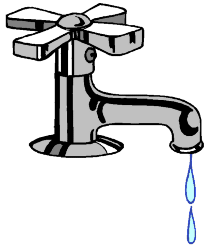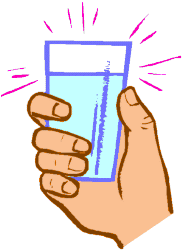by Larry
October, 2007On Tap
In researching what to do about the situation, I learned fresh vegetables are among the best foods to eat to correct our citizens' typical pH imbalance, but also that excess pH acidity can be significantly diluted as well as neutralized by simply drinking plenty of tap water, which is usually mildly alkaline from its dissolved mineral content. This led to a bit of further exploration of the pros and cons of tap water vs. the commercial bottled varieties that have become so popular. Some of the results of this investigation were interesting. With taxes, consumers can pay a buck or more for a commercial bottle of water, and they frequently drink at least a couple of them daily. This would cost then annually at least $730. Of course, the little bottles are handy, can easily be cooled in our refrigerators or those provided by employers, or can be purchased already chilled at our eateries. And they are much better for us, we hear, than the beverages we might drink instead, like, well, tap water. Right? Actually, studies have been done of the quality of tap vs. bottled water. Often the companies do very little to the water they put into individual containers to sell to us except bottle and label them to facilitate their sale. The bottles' contents may well be indistinguishable from ordinary tap water, except of course for the cost. A year's worth of tap water, at the same rate of consumption just indicated, would set us back far less than a buck. (On our water bill, the rate is $0.88 per 1000 gallons. So, to even cost a dollar a year, I would need to drink over 3 gallons of tap water a day. Add in a cup, prorating its expense over a decade or so, and I would still come out hugely ahead with tap water.) And if we do buy one or two of those cute little bottles to get convenient water fixes, why not just keep the same containers and reuse them? Of course, we would want to wash them from time to time, and we might even need three or four, so we could have a couple at the workplace as well as at home. Other water holders are available that would not cost as much, but no matter. The important thing is to keep one's expense for bottled water minimal by reusing whichever container one prefers. At most, this way a family of four would contribute for its lifetime water drinking needs only about 25 or less, total, to the number of plastic bottles pervading our environments.
But what about the distilled bottled water that companies like Coca-Cola provide us? Are they not superior to tap water and so worth the extra budgetary and environmental costs? Well, there is some debate about that, of course. The companies certainly have a vested and advertising interest in our believing so. They would have us think, for instance, that the minerals in water out of the tap are bad for us, as if, before modern distillation and packaging processes, we could only safely drink pure rain water. Many are convinced. Occasionally it may be wise for people to avoid tap water. There might be local, hopefully temporary health warnings due to fecal or other contamination of the city supply. Or individuals with special medical concerns, such as those involved in chemotherapy, battling HIV positive conditions, or who are pregnant, may want to be especially cautious about the quality of their water consumption. Then it would be savvy to be quite certain of the bottler's supply as well. There have been many problems with bottled and even so-called "distilled" water over the years.
After the reports of late about hazardous contaminants in imports from China, it is worth noting that some bottled water comes from abroad. The FDA has also found that bottles labeled as "distilled" often contain water that has not in fact been put through a distillation process. And random samples of bottled water have found over 20% containing bacteria, synthetic chemicals, or arsenic. It is ironic in view of the disparity in their costs, but unfortunately bottled water is often not checked and corrected for quality and health factors as frequently as are local tap water supplies. There are exceptions, but overall, for a variety of reasons an average commercial bottle of water may smell and look nicer than one's tap supply but is little if any healthier than what she or he can get for almost nothing at home. If concerned about the smell, appearance, or taste of tap liquid, we can have it tested, but chances are it is still just fine. There are also relatively inexpensive filtering remedies available for most of the taste, smell, or color questions folks have about their public utilities' provided water. Often a simple filter attachment on the fridge at home can make all the difference that is desired. Let us be careful how pure we make our drinking supplies. As in my case, the body needs some of those little mineral extras. They may seem a bit gross, but those provided in tap water are often rather good for our health. |
 By contrast, the family of four that has a throwaway approach and consumes two bottles a day is directly responsible for dumping over 2900 pieces of plastic garbage just to annually quench its thirst with bottled water. Over a lifetime, that is at least 200,000 new pieces of plastic out there, pieces that may be around for millions of years. Inevitably, huge tonnages of plastic waste cause landfill problems, wash into our streams and lakes, pollute our reservoirs, and reach the world's seas. Already, any given square nautical mile of ocean surface has 46,000 pieces of our plastic waste. Marine biologists find that almost every sea turtle, fish, sea mammal, or water bird has accidentally consumed some of our plastic.
By contrast, the family of four that has a throwaway approach and consumes two bottles a day is directly responsible for dumping over 2900 pieces of plastic garbage just to annually quench its thirst with bottled water. Over a lifetime, that is at least 200,000 new pieces of plastic out there, pieces that may be around for millions of years. Inevitably, huge tonnages of plastic waste cause landfill problems, wash into our streams and lakes, pollute our reservoirs, and reach the world's seas. Already, any given square nautical mile of ocean surface has 46,000 pieces of our plastic waste. Marine biologists find that almost every sea turtle, fish, sea mammal, or water bird has accidentally consumed some of our plastic.
